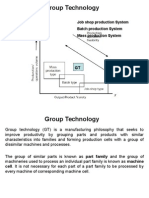Grouptechnology 140807034542 Phpapp01
Grouptechnology 140807034542 Phpapp01
Uploaded by
Larry Smith0 ratings0% found this document useful (0 votes)
21 views8 pagesGroup technology (GT) is a manufacturing philosophy that increases production efficiency by grouping parts with similar design and production characteristics into families. This allows companies to organize production equipment into machine cells to streamline material flow and improve efficiencies from reduced setup times and inventories. GT has evolved over the past 50+ years from early concepts in the 1920s to widespread adoption in many industries globally today, with continued development of techniques like cellular manufacturing systems.
Original Description:
group tech
Original Title
grouptechnology-140807034542-phpapp01
Copyright
© © All Rights Reserved
Available Formats
PPTX, PDF, TXT or read online from Scribd
Share this document
Did you find this document useful?
Is this content inappropriate?
Report this DocumentGroup technology (GT) is a manufacturing philosophy that increases production efficiency by grouping parts with similar design and production characteristics into families. This allows companies to organize production equipment into machine cells to streamline material flow and improve efficiencies from reduced setup times and inventories. GT has evolved over the past 50+ years from early concepts in the 1920s to widespread adoption in many industries globally today, with continued development of techniques like cellular manufacturing systems.
Copyright:
© All Rights Reserved
Available Formats
Download as PPTX, PDF, TXT or read online from Scribd
Download as pptx, pdf, or txt
0 ratings0% found this document useful (0 votes)
21 views8 pagesGrouptechnology 140807034542 Phpapp01
Grouptechnology 140807034542 Phpapp01
Uploaded by
Larry SmithGroup technology (GT) is a manufacturing philosophy that increases production efficiency by grouping parts with similar design and production characteristics into families. This allows companies to organize production equipment into machine cells to streamline material flow and improve efficiencies from reduced setup times and inventories. GT has evolved over the past 50+ years from early concepts in the 1920s to widespread adoption in many industries globally today, with continued development of techniques like cellular manufacturing systems.
Copyright:
© All Rights Reserved
Available Formats
Download as PPTX, PDF, TXT or read online from Scribd
Download as pptx, pdf, or txt
You are on page 1of 8
GROUP TECHNOLOGY
What is Group Technology ?
Group technology(GT) is a manufacturing philosophy to
increase production efficiency by grouping a variety of parts
having similarities of shape, dimension, and/or process route.
Thus in GT, similar parts are identified and grouped together to
take advantages of their similarities in design and production.
GT may be defined as a manufacturing philosophy that justifies
batch production by capitalizing on design and/or manufacturing
similarities among component parts.
For example, a plant producing many parts(say, 5000 different
parts) may be grouped into several distinct (say, 20 to 25 part
families).Each family possesses similar design and
manufacturing characteristics.
This grouping philosophy results in increased
manufacturing efficiencies.
Efficiencies are due to reduced setup times, lower inprocess inventories, better scheduling, streamlined
material flow, improved quality, improved tool
control, and the use of standardized process plans.
In many plants where GT has been implemented, the
production equipment is arranged into machine
groups (also known as cells) to facilitate work
flow and parts handling.
GENERAL ACHIEVEMENTS OF GROUP
TECHNOLOGY
HISTORY OF GROUP TECHNOLOGY
Group technology has been around for about five decades. Table
depicts a brief outline of how the GT concepts have evolved in
20th century.
Time
Prior to
1925
Events
F.W. Taylors scientific approach to management resulting
in rationalization of work and its break down leads to
greater need for standardization, inspection, and
supervision.
1925
R. Flanders presented a paper in USA before the American
Society of Mechanical Engineers (ASME) about a way of
organizing manufacturing at Jones and Lamson Machine
company, USA.
1937
A. Sokolovskiy of the Soviety Union described the essential
features of group technology.
He also proposed that parts of similar configuration be
produced by a standard process sequence.
1949
A.Korling of Sweden presented a paper in paris, France on
Group Production.
In his paper, he described how work is decentralized into
independent groups, each of which contains the machines
and tooling to produce a special category of parts
1959
S.P. Mitrofanvo, a Russian, published a book entitled
Scientific Principles of Group Technology.
His book was very popular and was responsible for
spreading the concept of GT in Soviet Union.
In fact, his book is considered responsible for over 800
plants in Soviet Union using GT by 1965.
1960
West Germany and Great Britain started serious studies into
group technology techniques : other European countries then
followed.
H. Opitz, a German researcher, studied workparts
manufactured by the German machine tool industry.
Opitz developed the popular parts classification and
coding system for machined parts (now, it is named by his
name Opitz parts classification and coding system.
1963
Concept of GT is well recognized and widely applied in many
industries in the Soviet Union.
1969
The first application of GT in USA was at New Jersey.
1973
Japanese government had begun sponsoring group
technology application.
1990+
Concept of cellular manufacturing system (CMS) have
evolved.
You might also like
- The Machine That Changed the World: The Story of Lean Production-- Toyota's Secret Weapon in the Global Car Wars That Is Now Revolutionizing World IndustryFrom EverandThe Machine That Changed the World: The Story of Lean Production-- Toyota's Secret Weapon in the Global Car Wars That Is Now Revolutionizing World IndustryRating: 4 out of 5 stars4/5 (8)
- Unit 6 From GrooverDocument41 pagesUnit 6 From GrooversimalaraviNo ratings yet
- Galileo Quick Reference Electronic TicketingDocument38 pagesGalileo Quick Reference Electronic TicketingSanjog Pandey75% (4)
- Bad Debt ProcessDocument12 pagesBad Debt Processachyuth100% (1)
- A History of Spatial MusicDocument9 pagesA History of Spatial Musicfgvfgvfgv100% (1)
- Operations Management Quiz and AnswersDocument2 pagesOperations Management Quiz and AnswersFomo5083% (6)
- 2012 10 Microsoft Visual Basic 2010 Step by StepDocument576 pages2012 10 Microsoft Visual Basic 2010 Step by StepAngel Valles100% (1)
- Group TechnologyDocument8 pagesGroup TechnologyTeck Soon TeoNo ratings yet
- Group Technology As A Manufacturing PhilosophyDocument4 pagesGroup Technology As A Manufacturing PhilosophyAnil AggarwalNo ratings yet
- Group TechnologyDocument15 pagesGroup TechnologySandeep KumarNo ratings yet
- Group TechnologyDocument5 pagesGroup TechnologyDivyeshNo ratings yet
- 1 PBDocument13 pages1 PBabcdNo ratings yet
- Material Unit - 2Document34 pagesMaterial Unit - 2gnanamanola sNo ratings yet
- Group Technology and Cellular Manufacturing2Document83 pagesGroup Technology and Cellular Manufacturing2harim_meNo ratings yet
- Group TechnologyDocument19 pagesGroup TechnologyCem Savaş AydınNo ratings yet
- CAPP - Summer 2015-Solution PDFDocument14 pagesCAPP - Summer 2015-Solution PDFsiddharth pandyaNo ratings yet
- Definition of 'Value Engineering': Cost ReliabilityDocument11 pagesDefinition of 'Value Engineering': Cost ReliabilityLaraNo ratings yet
- Lect 2. Types of Production Systems, Group Technology and Cellular Manufacturing SystemDocument79 pagesLect 2. Types of Production Systems, Group Technology and Cellular Manufacturing Systemraja harisNo ratings yet
- Industrial EngineeringDocument11 pagesIndustrial Engineeringmia farrowNo ratings yet
- Industrial Engineering The Toyota Production SystemDocument19 pagesIndustrial Engineering The Toyota Production SystemWahaaj AhmadNo ratings yet
- Evolution of Lean - PaperDocument7 pagesEvolution of Lean - PaperDash CorderoNo ratings yet
- Introduction: Classification of Layout, Advantages and Limitations of Different LayoutsDocument14 pagesIntroduction: Classification of Layout, Advantages and Limitations of Different LayoutsPadmavathi Putra LokeshNo ratings yet
- AMS - Hollier MehodsDocument78 pagesAMS - Hollier MehodsKapil MittalNo ratings yet
- Facility and Work Design PDFDocument30 pagesFacility and Work Design PDFrinalynNo ratings yet
- Fig. 1.1:the Growth of Techniques Associated With The WCM Concept Fig. 1.2:WCM Model by SchonbergerDocument1 pageFig. 1.1:the Growth of Techniques Associated With The WCM Concept Fig. 1.2:WCM Model by SchonbergerAkash KumarNo ratings yet
- 1 s2.0 S0272696306000313 Main PDFDocument18 pages1 s2.0 S0272696306000313 Main PDFalilounahdisteNo ratings yet
- Cad Cam Unit 4Document35 pagesCad Cam Unit 418-368 RRK Nikhil ChandraNo ratings yet
- Group Technology (GT)Document11 pagesGroup Technology (GT)Shanky JainNo ratings yet
- Group TechnologyDocument59 pagesGroup TechnologySRI RAMNo ratings yet
- Chapter 6 Group TechonologyDocument31 pagesChapter 6 Group TechonologyNguyễn Vinh QuangNo ratings yet
- 5 Group TechnologyDocument45 pages5 Group Technologymax hopusNo ratings yet
- JUST - IN - TIME PrintDocument29 pagesJUST - IN - TIME PrintGangadharRayanaikNo ratings yet
- Class 10-02-2023Document60 pagesClass 10-02-2023umesh javvadiNo ratings yet
- The Genealogy of Lean ProductionDocument18 pagesThe Genealogy of Lean ProductionLuiza VidaNo ratings yet
- Group Technology Final LDocument20 pagesGroup Technology Final LSpandhana PrayakaraoNo ratings yet
- UNIT I 1.6 Group-TechnologyDocument78 pagesUNIT I 1.6 Group-Technologyprof_panneerNo ratings yet
- The Evolution of Production Systems: Exploring The Sources of Toyota's CompetitivenessDocument20 pagesThe Evolution of Production Systems: Exploring The Sources of Toyota's CompetitivenessCatalina DNo ratings yet
- Furniture Industry ThesisDocument8 pagesFurniture Industry Thesiscrystaltorresworcester100% (2)
- Semester-Iii Assignment: University College of Commerce & Business ManagementDocument8 pagesSemester-Iii Assignment: University College of Commerce & Business ManagementRakyNo ratings yet
- IntroductionDocument2 pagesIntroductionAsael aguilarNo ratings yet
- Group TechnologyDocument30 pagesGroup TechnologyPadmavathi Putra Lokesh100% (1)
- 4 3 GT AbkDocument27 pages4 3 GT AbkadaviNo ratings yet
- Cellular Manufacturing Is A Model For WorkplaceDocument4 pagesCellular Manufacturing Is A Model For WorkplacePrashant AroraNo ratings yet
- Production System FacilitiesDocument3 pagesProduction System FacilitiesRuby SmithNo ratings yet
- Design of Assembly Systems For Modular Products: David W. He and Andrew KusiakDocument10 pagesDesign of Assembly Systems For Modular Products: David W. He and Andrew Kusiakalex5566No ratings yet
- Practical No.7: TheoryDocument12 pagesPractical No.7: TheoryMuhammad JahanzaibNo ratings yet
- Me - Emu.edu - TR Majid IENG447 IE 447 PDF FILES CIM Lecture Notes 6Document27 pagesMe - Emu.edu - TR Majid IENG447 IE 447 PDF FILES CIM Lecture Notes 6Rohit KundliyaNo ratings yet
- Group Technology & Cellular Manufacturing: Industrial Engineering Ft-UnsDocument40 pagesGroup Technology & Cellular Manufacturing: Industrial Engineering Ft-UnsinaNo ratings yet
- Vehicle Development ProcessDocument22 pagesVehicle Development ProcessIndranil BhattacharyyaNo ratings yet
- Assembly System Design and Operations PDFDocument19 pagesAssembly System Design and Operations PDFMohit SharmaNo ratings yet
- FMS Group 1Document39 pagesFMS Group 119M059 - PRANEET KANNA BNo ratings yet
- Group TechnologyDocument72 pagesGroup TechnologyNauman Khan100% (1)
- TAKT Planning and ControlDocument10 pagesTAKT Planning and ControlRobert WataniaNo ratings yet
- 08 Numisheet2008 Hot Forming Chapter8Document99 pages08 Numisheet2008 Hot Forming Chapter8rdouceNo ratings yet
- Group Technology and Cellular Manufacturing-IDocument20 pagesGroup Technology and Cellular Manufacturing-IVivekDinker100% (1)
- Purposes and Principles of Layout: IOME AssignmentDocument23 pagesPurposes and Principles of Layout: IOME Assignmentshubhamjain233No ratings yet
- Lean ManufacturingDocument17 pagesLean Manufacturingsophia787No ratings yet
- CHP - 51 - Cellular Manufacturing PDFDocument20 pagesCHP - 51 - Cellular Manufacturing PDFAdib HassanNo ratings yet
- Unit V GT and FMSDocument71 pagesUnit V GT and FMSSushanthNo ratings yet
- JIT - OR-Notes J E BeasleyDocument34 pagesJIT - OR-Notes J E BeasleyAjay KaulNo ratings yet
- Efficient Music Production: How To Make Better Music, FasterFrom EverandEfficient Music Production: How To Make Better Music, FasterRating: 4.5 out of 5 stars4.5/5 (2)
- Production Engineering - Jig And Tool DesignFrom EverandProduction Engineering - Jig And Tool DesignRating: 3.5 out of 5 stars3.5/5 (3)
- Scheduling: Theory, Algorithms, and SystemsFrom EverandScheduling: Theory, Algorithms, and SystemsRating: 4 out of 5 stars4/5 (1)
- The Global Manufacturing Revolution: Product-Process-Business Integration and Reconfigurable SystemsFrom EverandThe Global Manufacturing Revolution: Product-Process-Business Integration and Reconfigurable SystemsNo ratings yet
- 20041709Document62 pages20041709Larry SmithNo ratings yet
- ME 1004 NUCLEAR ENGINEERING Questions Bank 2014 Vidyarthiplus (V+) Blog - A Blog For StudentsDocument14 pagesME 1004 NUCLEAR ENGINEERING Questions Bank 2014 Vidyarthiplus (V+) Blog - A Blog For StudentsLarry SmithNo ratings yet
- Group Technology AND Cellular Manufacturing: Submitted By: GROUP NO: 8 (ROLL NO 1111041 TO 1111045)Document30 pagesGroup Technology AND Cellular Manufacturing: Submitted By: GROUP NO: 8 (ROLL NO 1111041 TO 1111045)Larry SmithNo ratings yet
- Ansys PDFDocument2 pagesAnsys PDFLarry SmithNo ratings yet
- Grouptechnology1 131203094018 Phpapp01Document9 pagesGrouptechnology1 131203094018 Phpapp01Larry SmithNo ratings yet
- Group Technology (GT)Document15 pagesGroup Technology (GT)Larry SmithNo ratings yet
- Cellular Manufacturing & Group TechnologyDocument24 pagesCellular Manufacturing & Group TechnologyLarry SmithNo ratings yet
- Gtbylathu 101231003739 Phpapp01Document25 pagesGtbylathu 101231003739 Phpapp01Larry SmithNo ratings yet
- Group Technology: Job Shop Production System Batch Production System Mass Production SystemDocument11 pagesGroup Technology: Job Shop Production System Batch Production System Mass Production SystemLarry SmithNo ratings yet
- ME2402-Computer Integrated ManufacturingDocument6 pagesME2402-Computer Integrated ManufacturingLarry SmithNo ratings yet
- Benefits of CIMDocument24 pagesBenefits of CIMLarry SmithNo ratings yet
- Turbofan Engine Working Principle, Performance and ApplicationDocument12 pagesTurbofan Engine Working Principle, Performance and ApplicationMé LıssąNo ratings yet
- GS TDLS200 - Edition 3 FinalDocument12 pagesGS TDLS200 - Edition 3 FinalApisitUsungnoenNo ratings yet
- Checklist: Element No. Elements Description Action Items From Previous ISO AuditsDocument9 pagesChecklist: Element No. Elements Description Action Items From Previous ISO AuditsEng Muhammad Marzouk100% (3)
- Experiment 4 - Frequency Modulation Using ScilabDocument6 pagesExperiment 4 - Frequency Modulation Using ScilabCleiton Marques0% (1)
- Vdci Mep Bim CertificateDocument5 pagesVdci Mep Bim CertificateMuhannad AbdulRaoufNo ratings yet
- HK3490 PDFDocument108 pagesHK3490 PDFcoolruler40No ratings yet
- M 15Document2 pagesM 15Александр ОстапенкоNo ratings yet
- Ultrasonic Flow Meter 201 and 221Document14 pagesUltrasonic Flow Meter 201 and 221royNo ratings yet
- Design of Air Conditioning and Ventilation System of The Gymnasium in The Polytechnic University of The Philippines Maragondon Campus 1Document85 pagesDesign of Air Conditioning and Ventilation System of The Gymnasium in The Polytechnic University of The Philippines Maragondon Campus 1davidjoshua.mmNo ratings yet
- Kobalt Lowes ChargerDocument16 pagesKobalt Lowes ChargerjchistiaNo ratings yet
- Tekla User AssistanceDocument14 pagesTekla User AssistanceRajlić ZoranNo ratings yet
- ETLDocument3 pagesETLAbiNo ratings yet
- SysSocketAsync V3x EDocument7 pagesSysSocketAsync V3x Emuhamad.badar9285No ratings yet
- Thermodynamics Sample ProblemDocument1 pageThermodynamics Sample ProblemNiel ReproponioNo ratings yet
- Antenna MeasurementDocument40 pagesAntenna MeasurementMichelle Nyamupanemunda100% (1)
- MIMO Wireless CommunicationDocument170 pagesMIMO Wireless CommunicationAli Ahmad100% (2)
- Crowd Noise and Vocal Power Level in Large College Canteens in China PDFDocument19 pagesCrowd Noise and Vocal Power Level in Large College Canteens in China PDFRutvik ChawareNo ratings yet
- The Birth of A Space Nation: James Mangan CoinsDocument2 pagesThe Birth of A Space Nation: James Mangan CoinsJelena PopovicNo ratings yet
- Explanacao Controle HVBDocument24 pagesExplanacao Controle HVBFranciscley CardosoNo ratings yet
- Evernight 3 PDFDocument2 pagesEvernight 3 PDFBradNo ratings yet
- 200 Sets in One Made by ToddyDocument60 pages200 Sets in One Made by ToddymissescatherinekooperNo ratings yet
- Radio Car BaseDocument80 pagesRadio Car Basetalenestorov50% (4)
- ME-6105 HW1 InjectorDocument8 pagesME-6105 HW1 InjectordromakiNo ratings yet
- STS-39 Press KitDocument48 pagesSTS-39 Press KitBob AndrepontNo ratings yet
- Super Speed USB 30 OverviewDocument7 pagesSuper Speed USB 30 OverviewDawalibiahmadNo ratings yet




































































































